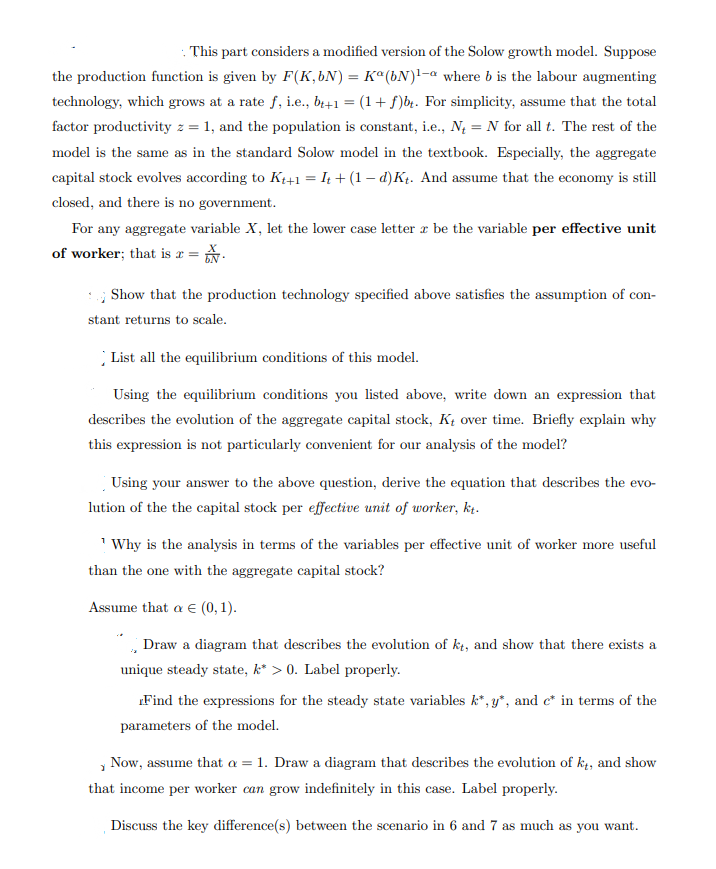This part considers a modified version of the Solow growth model. Suppose the production function is given by F(K,bN) = Kª(bN)!-ª where b is the labour augmenting technology, which grows at a rate f, i.e., b+1 = (1+ f)bt. For simplicity, assume that the total factor productivity z = 1, and the population is constant, i.e., N, = N for all t. The rest of the model is the same as in the standard Solow model in the textbook. Especially, the aggregate capital stock evolves according to Kt41 = I + (1 – d)K1. And assume that the economy is still closed, and there is no government. For any aggregate variable X, let the lower case letter æ be the variable per effective unit of worker; that is r = . Show that the production technology specified above satisfies the assumption of con- stant returns to scale. ; List all the equilibrium conditions of this model. Using the equilibrium conditions you listed above, write down an expression that describes the evolution of the aggregate capital stock, Kį over time. Briefly explain why this expression is not particularly convenient for our analysis of the model?
This part considers a modified version of the Solow growth model. Suppose the production function is given by F(K,bN) = Kª(bN)!-ª where b is the labour augmenting technology, which grows at a rate f, i.e., b+1 = (1+ f)bt. For simplicity, assume that the total factor productivity z = 1, and the population is constant, i.e., N, = N for all t. The rest of the model is the same as in the standard Solow model in the textbook. Especially, the aggregate capital stock evolves according to Kt41 = I + (1 – d)K1. And assume that the economy is still closed, and there is no government. For any aggregate variable X, let the lower case letter æ be the variable per effective unit of worker; that is r = . Show that the production technology specified above satisfies the assumption of con- stant returns to scale. ; List all the equilibrium conditions of this model. Using the equilibrium conditions you listed above, write down an expression that describes the evolution of the aggregate capital stock, Kį over time. Briefly explain why this expression is not particularly convenient for our analysis of the model?
Chapter20: Economic Growth In The Global Economy
Section: Chapter Questions
Problem 5P
Related questions
Question

Transcribed Image Text:This part considers a modified version of the Solow growth model. Suppose
the production function is given by F(K,bN) = Kª(bN)!-ª where b is the labour augmenting
technology, which grows at a rate f, i.e., bt+1 = (1+ f)bt. For simplicity, assume that the total
factor productivity z = 1, and the population is constant, i.e., N, = N for all t. The rest of the
model is the same as in the standard Solow model in the textbook. Especially, the aggregate
capital stock evolves according to K++1 = It + (1 – d)Kį. And assume that the economy is still
closed, and there is no government.
For any aggregate variable X, let the lower case letter a be the variable per effective unit
of worker; that is x = *.
Show that the production technology specified above satisfies the assumption of con-
stant returns to scale.
List all the equilibrium conditions of this model.
Using the equilibrium conditions you listed above, write down an expression that
describes the evolution of the aggregate capital stock, Kt over time. Briefly explain why
this expression is not particularly convenient for our analysis of the model?
Using your answer to the above question, derive the equation that describes the evo-
lution of the the capital stock per effective unit of worker, kt.
' Why is the analysis in terms of the variables per effective unit of worker more useful
than the one with the aggregate capital stock?
Assume that a E (0, 1).
Draw a diagram that describes the evolution of kt, and show that there exists a
unique steady state, k* > 0. Label properly.
Find the expressions for the steady state variables k*, y*, and c* in terms of the
parameters of the model.
, Now, assume that a = 1. Draw a diagram that describes the evolution of k4, and show
that income per worker can grow indefinitely in this case. Label properly.
Discuss the key difference(s) between the scenario in 6 and 7 as much as you want.
Expert Solution
This question has been solved!
Explore an expertly crafted, step-by-step solution for a thorough understanding of key concepts.
This is a popular solution!
Trending now
This is a popular solution!
Step by step
Solved in 2 steps with 1 images

Knowledge Booster
Learn more about
Need a deep-dive on the concept behind this application? Look no further. Learn more about this topic, economics and related others by exploring similar questions and additional content below.Recommended textbooks for you

Exploring Economics
Economics
ISBN:
9781544336329
Author:
Robert L. Sexton
Publisher:
SAGE Publications, Inc

Exploring Economics
Economics
ISBN:
9781544336329
Author:
Robert L. Sexton
Publisher:
SAGE Publications, Inc